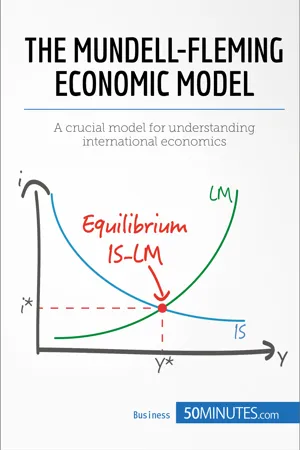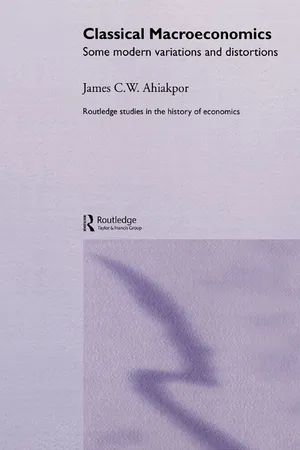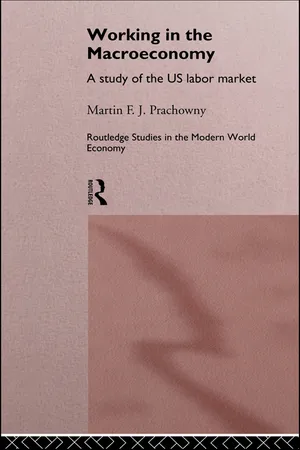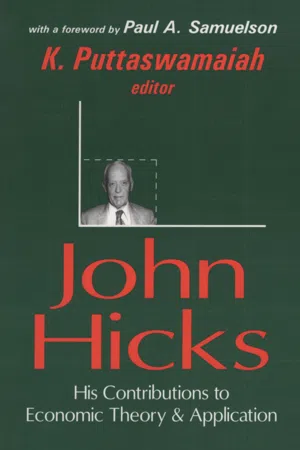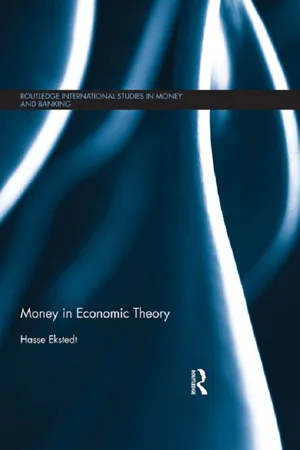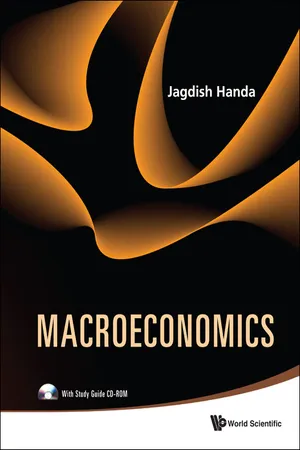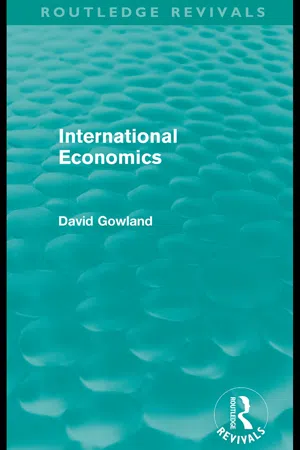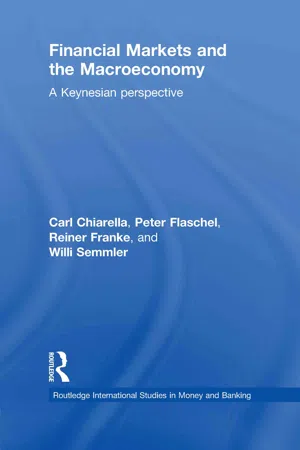Economics
IS LM Model
The IS-LM model is a framework used to analyze the relationship between interest rates and output in an economy. The "IS" curve represents equilibrium in the goods market, while the "LM" curve represents equilibrium in the money market. By examining the intersection of these two curves, the model provides insights into the impact of monetary and fiscal policies on the economy.
Written by Perlego with AI-assistance
Related key terms
Related key terms
1 of 4
Related key terms
1 of 3
10 Key excerpts on "IS LM Model"
- eBook - ePub
The Mundell-Fleming Economic Model
Achieving macroeconomic equilibrium
- 50minutes(Author)
- 2015(Publication Date)
- 50Minutes.com(Publisher)
- The creation of money is endogenous, i.e. it is possible for authorities to vary the money supply at will;
- The model is valid for a closed economy.
The IS-LM model includes the dynamics of two markets: the goods and services market and the money market. Goods are either consumed (called ‘consumer goods’) or invested (called ‘capital goods’). Money is requested by economic agents (firms and households) for reasons of income (to fill the time between receipt and disbursement), precaution (to cope with unexpected expenses), or speculation (to purchase securities in speculative purposes) and for business or household reasons (to cover everyday expenses).The model is in the form of two curves, one reflecting the balance in the goods and services market (IS), the other showing the balance of the currency market (LM). The model can simultaneously determine the balance in both markets by establishing relationships between the interest rate (i ) and the level of activity, also called the level of production or income (Y ).The IS curve
The IS curve represents all combinations of interest rate (i ) and income (Y ) that ensure balance on the goods and services market. On this market, with a given general price level, income (Y ) is divided between consumption (C ) and savings (S ) (Y = C + S ), and between consumption and capital goods (I ) (Y = C + I ).If we consider that all income from production is actually distributed, or Y = Y , then we achieve macroeconomic equilibrium C + S = C + I and I = S , which can be further expressed as I(i) = S(Y).- Investment is a decreasing function of the interest rate (rising interest rates increase the cost of financing for enterprises and reduce the return on investment).
- Savings are an increasing function of income (the richer a person, the more they save).
Thus, there is a decreasing relationship between income (Y) and interest rate (i). If the interest rate increases, investment decreases. Due to the multiplier, investment affects the level of production. The IS curve is decreasing and is represented as follows: - eBook - ePub
- James C.W. Ahiakpor(Author)
- 2003(Publication Date)
- Routledge(Publisher)
For some users of the model, the hope seems to be that continuing research in macroeconomic analysis will provide the means for correcting its major deficiencies for it to capture better the workings of a monetary economy, for example, Leijonhufvud (1983), Hillier (1986), Mankiw (1990), and Patinkin (1990). 2 Darity and Young, after their extensive “inquest” into the IS-LM model, are also unable to decide whether the model should be “vilified for its elusive, chameleon-like character or be cherished for its flexibility” (1995:1). But they anticipate that “in its variegated forms” the model will not be “forsaken” and probably will continue to “rule the roost” in the teaching of macroeconomics (37). This chapter explains the success of the IS-LM model in propagating Keynesian economics and Keynes’s misrepresentations of classical macroeconomics, and why the model’s principal deficiencies appear hardly remediable. The IS-LM model The modern IS-LM model derives from J.R.Hicks’s original 1937 article aimed at helping to settle the disputes that arose following the publication of Keynes’s General Theory (1936). The model attempts to depict a simultaneous determination of equilibrium in the market for goods and services (IS) as well as for money variously defined (LM), with respect to the rate of interest and national income. Equilibrium in the market for goods and services is achieved when aggregate output or income just equals aggregate demand (AD) for consumption (C), investment (I), and government expenditure (G) for a closed economy that is, According to the model, equilibrium income falls when AD declines relative to income, because of the build-up of unintended inventories that have to be reduced through a cutback in production and employment - eBook - ePub
- Indranarain Ramlall(Author)
- 2018(Publication Date)
- Emerald Publishing Limited(Publisher)
Figure 5.3 . The LM curve captures equilibrium in the money market and is built based on a positive relationship between interest rate and real national income.Figure 5.3: Derivation of the LM Curve. Source : Author’s illustration.Readers can try on their own to appreciate the fact that a rightward shift in the LM curve can be caused either by a rightward shift in the money supply or a decline in money demand.5.8. Equilibrium in Both Real and Monetary Sectors Under IS-LM Framework
The overall equilibrium is derived by the intersection of the IS and LM curves. At such a point, the goods market referred to as the real sector is equal to the financial market referred to as the monetary sector.Different schools of thoughts assume different slopes with respect to the IS and LM curves. As a matter of fact, which policy is more effective rests upon the distinction between the monetary policy and the fiscal policy in controlling the economy. The extreme monetarist presumes a perfectly elastic IS while a perfectly inelastic LM curve. Thus for the monetarists, monetary policy is very powerful while fiscal policy is not effective at all. However, the extreme Keynesian assumed a perfectly inelastic IS curve and a perfectly elastic LM curve. Thus, any shift in the IS curve will entail a full effect on the level of real income with zero effect on interest rate and zero crowding-out effect such that fiscal policy is very powerful. However, any shift in the LM curve does not affect real income since it intersects IS curve at the same point. Monetary shocks cause no instability because monetary policy is impotent. Figure 5.4 - eBook - ePub
- Martin F. J. Prachowny(Author)
- 1997(Publication Date)
- Routledge(Publisher)
4A Model of the Macroeconomy
The labor market does not operate in isolation; it interacts with goods markets and asset markets to determine three important macroeconomic variables: (1) the inflation rate, (2) the interest rate, and (3) the unemployment rate. The macroeconomic model to be presented in this chapter is not complicated and is to be found in almost any textbook in macroeconomics. In fact, it is based on the well-known IS-LM-AS relationships, with the only claimed novelty being the emphasis on the micro-foundations of labormarket transactions developed in the previous chapter. From the goods market, we derive the IS curve which shows combinations of income and the interest rate that keep unintended inventories from appearing. In the money market, equilibrium is maintained along the LM curve which is again a locus of points in income-interest-rate space. Finally, the labor market provides us with the aggregatesupply curve via a production function and the laboruse equation. The AS curve is a relationship between output or income and the rate of inflation. The economy is assumed to be closed to international transactions to maintain simplicity, but an open-economy version of the model could be developed by introducing these transactions in the goods or asset markets.14.1 The Building Blocks of the Model
Because there are a number of variables such as the inflation rate that are expressed as “rates of change,” it is more convenient to work with natural logs than with the original units of account. In fact, they make it much easier to deal with inflation as a continuing phenomenon.4.1.1 The IS Curve
Equilibrium aggregate demand in the goods market is attained when unintended inventory accumulation or decumulation is absent. This requires that planned saving equals intended investment or, in a more complicated version of the economy, when ex ante saving plus taxes equal ex ante investment plus government expenditures. Saving and taxes are positively related to the level of income, investment expenditures are determined partly by income and partly by the real interest rate, while government expenditures are treated as being exogenous to the model (i.e., they are presumed to be determined by the legislative process). Therefore, defining S as the natural log (from now on written as In) of saving plus taxes, I as In of investment plus government expenditures, y as In of income, and i− e - eBook - ePub
John Hicks
His Contributions to Economic Theory and Application
- K. Puttaswamaiah(Author)
- 2018(Publication Date)
- Routledge(Publisher)
Following Tobin, Solow described ISLM as the trained intuition of many of us (1984, p. 16). ISLM neglects the supply side. Yet when the profession changed to aggregate demand and supply models as the usual way of teaching, and thinking about, macroeconomics, ISLM was widely used to derive the aggregate demand curve in these models. Thus, it still occupies an important place in macroeconomics. However ISLM came to be supported much less wholeheartedly by its creator than by the majority of the economics profession. In what he called his post-Keynesian, or neo-Wicksellian phase (1982, p. xii) Hicks became increasingly dissatisfied with ISLM. In “IS-LM – An Explanation” (1980-1) he spelt out the reasons for this dissatisfaction. They arose from the way time is treated in the model and in particular how this is reflected in the concepts of equilibrium and expectations in ISLM. Hicks denotes a substantial proportion of “IS-LM – An Explanation” to describing how his original 1937 article “Mr Keynes and the ‘Classics’: A Suggested Interpretation” cast Keynes’ analysis into a Walrasian general equilibrium framework. He points out that the model is one which describes the equilibrium position of an economy in a particular period, with a past, that has determined the capital stock and various other variables, and a future about which expectations are exogenous and fixed throughout the period. The period had to be quite long since in Keynes analysis “quite a lot of things had to happen” (1980-1, p. 141) for equilibrium to occur. It also had to be not too long since Keynes assumed a constant stock of capital. “We shall not go far wrong”, Hicks says, “if we think of it [the period] as a year” (ibid.). Hicks points out that in his model the economy had to be treated as if it were in equilibrium over the whole period, the whole of this “year”, and that this is true both for the IS relationship and the LM relationship (1980-1, p. 151) - eBook - ePub
- Krish Bhaskar, David F. Murray(Authors)
- 2015(Publication Date)
- Routledge(Publisher)
5 The Keynesian Islm SystemDOI: 10.4324/9781315677064-5Introduction
This chapter is concerned with the Keynesian ISLM model of the goods and money markets. It is based on the Hicks-Hansen1 interpretation2 of Keynes’ writings (the so-called income-expenditure model) and shows how a joint equilibrium of the goods and money markets is achieved. This equilibrium determines, amongst other things, the equilibrium quantity of real output or income demanded in the economy and the effect of government fiscal and monetary policy actions on this equilibrium is demonstrated. A simple aggregate demand curve showing the equilibrium quantity of real output demanded at each price level is also derived. In addition the implications for government policy action and the aggregate demand curve of the possibility of interest inelastic investment and the liquidity trap are considered.The goods market
The savings decision
Keynes’ own work referred to consumption but as we have already seen if we have a theory of the determination of consumption we also have a theory for savings since savings are what is left over out of income after the consumption decision. The Keynesian consumption function3 is based on the fundamental psychological proposition that consumption is a stable and increasing function of real income and that the marginal propensity to consume lies between zero and unity. This implies that savings will also be a stable function of real income and that the marginal propensity to save, sY - eBook - ePub
- Hasse Ekstedt(Author)
- 2012(Publication Date)
- Routledge(Publisher)
The concept stemmed from Muth (1961) who used it for short-run expectations for well-defined commodity markets on the microscopic level. Generally it seems that it was forgotten that the neoclassical synthesis, IS-LM, was a macroscopic theory for which neoclassical theory was an appropriate foundation completed with the money side of the economy. As Paul Krugman claims on his homepage, the IS-LM might be seen as an enlarged neoclassical model. 4 Furthermore the concept of rational expectation was shown, as in Radner (1982), to be rather obscure in its use on general macroscopic problems and most of the elements in it could be traced back to Keynes’ beauty contest. 5 The debate sooner concerned the developed political practice around the IS-LM model containing the questions about the Phillips curve and we will later see that this was a constructive approach but it hardly belonged to the Keynesian theory expressed in IS-LM, particularly if we regard Hicks’ problem with technological differences between production sectors which already appeared in his illustration of the classical model. Keynesianism and the neoclassical synthesis The Keynesian theory as it appears in the IS-LM model, deals with interest, money and to some extent liquidity but where are the prices? Thus Hicks’ question in the last quote above about the relation between prices and interest is relevant, particularly since Keynes was aware of the problem of changing dimensionality of the commodity space. In principle the model worked as illustrated in Figure 4.4 with respect to national income and the price level. Nothing happens to the prices until we have full capacity utilization. An increase in demand in full capacity utilization adds nothing to the real national income but only to the price level, it is said nothing in the model of the relative prices. Thus we have a rather comfortable world from an economic policy point of view - eBook - ePub
Macroeconomics
(With Study Guide CD-ROM)
- Jagdish Handa(Author)
- 2010(Publication Date)
- WSPC(Publisher)
r on the vertical axis.Restating the LM equationThe LM equation derived above was:Using the assumption that π e = 0, so that R = r, we replace R in the money demand and LM equations by r. This turns the LM equation (5) into:Now substitute this value of the interest rate in the IS equation. The resulting AD equation for the open economy is: where: 6.6.3 Diagrammatic determination of aggregate demandFigure 6.6 a draws both the IS and the LM curves in the same diagram. The intersection point of the IS and LM curves provides those values of r (and R under our assumption that πe = 0) and y at which there is simultaneous equilibrium in both the commodity and money markets. This point shows the aggregate demand for commodities, after incorporating the impact of the money market on the interest rate, which is needed to determine investment in the commodity market. The demand curve thus derived — just as for demand curves in microeconomic analysis — specifies the quantity demanded of commodities as a function of the price of commodities.In Figure 6.6 a, start with the IS curve and the LM curve, labeled as LM0 | M0 /P0 . The latter is drawn for an initial money supply M 0 and an initial price level P 0 . Their intersection at the point d0 indicates the level of aggregate demand yd, at the price level P0 . If, for the given money supply, the price level were somehow to fall to P1 (P 1 < P 0 ), the LM curve would shift to the right to LM1 | M0 /P 1 . Then, the intersection of the IS and the LM1 curves would occur at the point d 1 , so that the level of aggregate demand would become y d 1 , at the price level P 1 - eBook - ePub
- David Gowland(Author)
- 2010(Publication Date)
- Routledge(Publisher)
The IS-LM model is usually presented as either a closed economy model or as a pseudo-open economy version. In the latter case ‘sterilisation’ is assumed, i.e. balance of payments surpluses and deficits are not allowed to influence the money stock, as well as the obvious addition of exports and imports to the withdrawals and injections of the IS curve. As always one can have real income, prices or nominal income on the horizontal axis, in the first two cases price and real income respectively are held constant. It is simplest if prices are held constant, so this will be assumed here.The first addition to the model is an explicit consideration of theFigure 7.5: An Open Economy IS-LM Modelbalance of payments. The easiest way to do this is to add an external balance line (FF) to Figure 7.5 representing levels of income and interest rates which generate a balance of payments equilibrium. If one is interested only in the current account it is possible to argue that FF should be vertical—with exogenous exports and fixed price, imports should depend only on income, hence only one level of income will generate equilibrium. Alternatively it could slope backwards—if interest is paid on foreign deposits a higher rate of interest causes a deficit. Usually, however, a Mundell model upward sloping curve for the overall balance is used. Although real income, not government spending, is on the horizontal axis, the same arguments apply, as G influences the balance of payments through Y. Any point to the right of the FF curve represents a deficit (higher income and so more imports) and any point to the left a surplus. Obviously FF could be to the left or right of the equilibrium level of Y and r, YE , rE , i.e. there could be either a surplus or a deficit when the goods and the money markets are otherwise in equilibrium. In Figure 7.5 the initial deficit case is assumed—though as the argument is symmetric the reader can easily work through the alternative of an initial surplus.The initial deficit reduces the money supply so the LM curve shifts to the left (Figure 7.6 ). A deficit reduces the money supply in a variety of ways. The simplest are1. if the government supplies foreign currency to residents to purchase imports, this operates exactly like an open market operation;2. the ownership of bank deposits may be effectively transferred to foreigners to pay for imports, e.g. if I write a cheque to pay for French wine and the French supplier keeps a deposit with a UK bank. (Foreign-owned deposits are excluded from UK definitions of money.) - eBook - ePub
- Carl Chiarella, Peter Flaschel, Reiner Franke, Willi Semmler(Authors)
- 2009(Publication Date)
- Routledge(Publisher)
As q impacts positively on aggregate demand (while in the familiar textbook story the interest rate impacts negatively on Y d), this IS curve is upward-sloping (rather than downward-sloping, when Y d depends on i). In addition, if q is held constant, then all non-equilibrium points are attracted by the IS curve. These features are illustrated in Figure 2.4. Note that the IS curve must cut the horizontal axis at a positive value, since the autonomous term in the aggregate demand function has been assumed as positive (representing basically the in”uence of “scal policy on aggregate demand). The IS curve will shift to the right if”scal policy is expansionary and it will be steeper with smaller a y, the value of the marginal propensity to spend. Figure 2.4 The IS curve (representing goods market equilibrium). 2.3.3 The LM Curve: q̇ = 0 In analogy to the treatment in the previous subsection, the second law of motion may be set to rest. This means that the stock market is in temporary equilibrium… in conjunction with money market equilibrium, which by (2.2) and i(Y) entering (2.8) is presupposed anyway. Although i (Y) was said to derive from a familiar LM condition, it will be convenient from now on to call the locus of pairs (Y, q) giving rise to (2.8) = 0 an LM curve. We stress that the LM curve of this chapter represents money market and stock market equilibrium and is thus more complex than the usual LM curve of the textbook literature (and in particular, not always positively sloped as in the case of the simple money market LM curve, see below). This curve, however, is unstable. Suppose share prices and, thus, Tobin•s q are so high that i (Y) q – r (Y) > 0, which says that the short-term interest rate i exceeds the direct returns r p K from holding equities when these are related to the value of shares (this rate of return being given by rpK/p e E = r/q). In this situation share prices are driven up even higher, according to q̇ > 0 in (2.8)
Index pages curate the most relevant extracts from our library of academic textbooks. They’ve been created using an in-house natural language model (NLM), each adding context and meaning to key research topics.
Explore more topic indexes
Explore more topic indexes
1 of 6
Explore more topic indexes
1 of 4
